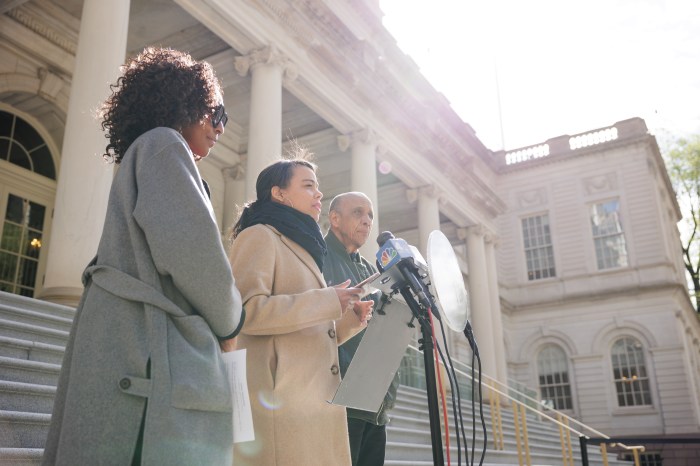
Lots of people walked by the new-looking but still funky van on Greenpoint Avenue, but Teresa Czerkies paused. The van featured a mural depicting smiling people and ice cream vendors and colorful buildings painted on its side.
Above the rear wheel a video screen played subtitled testimonials of New Yorkers finding affordable housing. Czerkies, 52, wanted affordable housing. Of course she does: She’s a New Yorker.
Bundled up in her pink hat and heavy jacket, Czerkies was the van’s target audience. The van had recently been purchased for some $120,000 by two borough presidents to aid outreach for NYC Housing Preservation and Development, the agency responsible for promoting and regulating below-market-rate housing. A new waterfront building with 140 of those precious units will be opening at 23 India St. a few blocks away from where the HPD staffers were parked in Greenpoint last week. Those apartments will be available by lottery to people whose income falls between certain bands: there are studios, for example, priced at $613 a month for someone making between $22,903 and $26,720 a year. Many people aren’t aware of such options. So the van — home to a laptop and printer plus plenty of paperwork and a four-person outreach team — was there to encourage people to try their luck, in addition to distributing other housing information.
The building would be gold for Czerkies. She’d like to live in the neighborhood, near her job at a doctor’s office. Much more convenient than the three-train commute she said she takes from Broadway Junction, where the rents are cheaper.
“I want to live here,” she said. But without scoring one of the affordable units slotted for her income range — a little over $400 a week — she’d be hard-pressed to do so.
Mayor Bill de Blasio has made housing affordability a centerpiece of his mayoralty, and in January he announced some 25,000 affordable homes had been built or preserved in 2017, an all-time high.
Still, that’s just a fraction of what’s needed. One indication of the frenzied affordable housing market: about 700 applications are received for each affordable unit in housing lotteries, according to HPD. That’s down from around 900 applications per unit in fiscal year 2016, but up from 600 per unit in fiscal year 2014, the first year of online lotteries.
Some reports indicate the number of applications per unit is much higher for apartments in popular areas like downtown Brooklyn.
Clearly there is a supply problem. Partially that is because even the administration’s affordable construction efforts end up being small in comparison to the unregulated (often: luxury) construction coming on line.
The new development at 23 India St. is a good example. The owner is receiving subsidies to make the site’s 140 units affordable. Next door, but closer to the river, the same developer has a market rate tower that includes 463 units of condos and market-rate rentals. That’s more than three times the number of units that will be feverishly lotteried off next door.
The long odds are only one part of the challenge for an actual human to get an affordable unit. There’s also all the complicated paperwork. The gas bills and pay stubs are par for the course for many renters in NYC, but credit checks and a clean eviction history can be particularly difficult for low-income tenants, notes Oksana Mironova, a housing policy analyst at the nonprofit Community Service Society of New York. HPD requires the developers who make decisions on rental applications not to use credit scores as sole reasons for denial, but the eviction question can create issues, Mironova says.
That’s where the van and its staff might help — in clarifying the application process. The housing supplicant can hop into the backseat for a while and peruse income guides and informative, well-bound packets that perhaps you’d have room for on a bookshelf in your spiffy new place.
Unfortunately you can’t submit a one-stop application for affordable housing inside. The online application takes many steps, and outreach workers refer dwelling-seekers to local “housing ambassadors,” nonprofits who can guide you through the process.
It’s slow going. Angie Robinson, the HPD assistant commissioner who was leading the outreach team last Monday, said the van had engaged 60 people in three visits the week before as the team warmed to the mission.
Czerkies left the van hopeful, the possibility of 23 India St. still glittering ahead. She had also applied for a job as a school safety officer. Like the affordable housing process, she just had to cross her fingers and wait.
“It’s a long, long process,” she said.

















